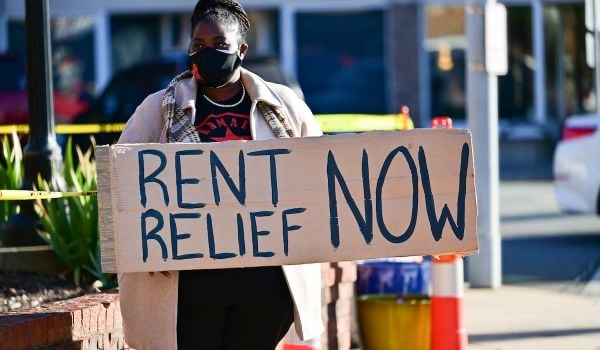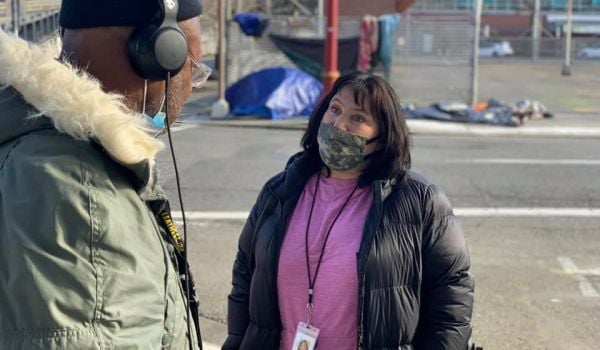About noon, lunch is served at Mary Hall, a Catholic Charities-run homeless housing facility in St. Paul, Minn. That’s about the time that Marcellus Rose shows up. A 66-year-old outreach worker for Open Access Connections in the Twin Cities, Rose is there to sign up homeless people for discounted phone and internet service through the federally-subsidized Lifeline program. As Rose puts it, “You got to have communication in society these days or you are obsolete.”
Rose should know. He’s one of the millions of low-income people who rely on Lifeline. If it wasn’t for the service, he says, he might be homeless, too; he spent five years on the streets until finding a public housing apartment using his Lifeline phone. “With Lifeline I was able to communicate with public housing and a bunch of facilities that had affordable housing,” he says.
But Lifeline is under threat, and advocates say communities of color, rural towns, Tribal nations, and the urban indigent could face new barriers to access to cell phones and the internet. The FCC has proposed reforms that, combined, could disrupt service for millions of Americans. One of the most contentious would ban “resellers” that provide the vast majority of service for people who count on Lifeline. Resellers sell their phones under various brands like TracFone or Assurance Wireless, and don’t own their own communications infrastructure — they are literally reselling the bandwidth of the largest carriers. Another proposed changeset a budget cap on the Lifeline program for the first time, and would phase out voice service except for rural areas.
The FCC voted 3-2 along party lines to move forward with proposing the new rules last November, and the public comment period ended in March of 2018. The agency recently told Congress it was still reviewing comments.
The Lifeline program currently serves an average of 12 million households at any given time, according to the Government Accountability Office. It was created in 1984 under President Reagan with the intent to connect low-income households with reliable phone service. Since then, the program has expanded to deliver both mobile and broadband services. As of December 2017, the Lifeline discounted service rate is $9.25 per month for voice and broadband; eligible Tribal subscribers may have to pay an additional $25 per month. The program is subsidized through a fee on telecommunications providers.
Big telecom companies, rightwing organizations, progressive advocates, and scholars have all come out in opposition to the FCC’s proposed reforms.
“This is a very scary proposal,” says Olivia Wein, a staff attorney with the National Consumer Law Center and an expert on Lifeline policy. “The scope of the impact is so dramatic that it is breathtaking for us.”
She said cutting off resellers might leave some areas with no options for service, while capping the budget might force the program to prioritize who gets Lifeline. “Any time you propose something like that, administering Lifeline becomes a lot more complex because you have to create some kind of waiting list,” she said.
Yet Ajit Pai, chairman of the FCC, is determined that Lifeline be retooled. He has called the reforms to Lifeline necessary to protect consumers, improve service, combat fraud and waste, and narrow the digital divide. For instance, he has argued that disallowing resellers to operate through Lifeline will lead to investment in telecommunications infrastructure where it is needed.
“Far too many Americans lack the affordable broadband options that many of us take for granted,” Pai said in a statement last year. “And for far too long, policymakers have let unscrupulous wireless resellers waste Lifeline funding rather than demand these funds go to support real digital opportunity and infrastructure in underserved communities.”
Advocates and others who are opposed to the reforms argue there’s no evidence that cutting off resellers from Lifeline would lead to infrastructure investment by telecom companies. They argue that reforms would actually widen the digital divide. Major municipalities, including the Boston and Los Angeles, have filed comments to the FCC arguing that the changes could disenfranchise their residents. The City of New York argued that one proposed reform would actually limit opportunities for broadband access for public housing residents. “New York City needs companies willing to make new investments that benefit customers with varying levels of means, including and especially those in public housing,” the city said.
And while Lifeline has been susceptible to fraud and abuse due to its reliance on verification by resellers — a 2017 report by the U.S. Government Accountability Office said that the agency couldn’t confirm whether 1.2 million individuals in the program were qualified — advocates underscore the fact that major reforms are underway. For instance, a 2016 FCC order called for the establishment of a national eligibility verifier by 2019. The system is now operating in six states.
For now, organizations that help people get Lifeline service are waiting anxiously for the FCC to make its final decisions on the reforms. Mark Erpelding, executive director of Open Access Connections in Minnesota, says the changes would limit his organization’s ability to serve low-income and homeless people in the Twin Cities. That’s because the phones his organization distributes are provided by EnTouch Wireless, one of the resellers that could be banned.
“We would try to raise funds to offer phones to some people, but there simply is not enough philanthropic dollars to replace the loss of the Lifeline program,” he says via email. “There also would be a huge administrative cost in managing the phones on our own. At best we would be able to raise and pay for a hundred phones, compared to the thousands of people currently served in Minnesota alone.”
Rose Urman, 63, also works for Open Access Connections as an outreach worker. She says for many low-income people she meets, daily expenses often come before the phone bill. And for people who need to keep in touch with their probation officers or people with chronic illness who need to stay connected to doctors, the Lifeline phone’s discounted service is a blessing they could otherwise not afford, she says.
It also helps people who have been on the streets to stay connected to family. “I gave a phone to a guy the other day and he called his mom first,” Urman says.

Cristian Salazar spent over a decade as a daily journalist. He worked as a crime reporter in Paterson, N.J., and as a newsman for The Associated Press in New York City. His stories have appeared in The Washington Post, The Daily Beast and several other publications. He was born in Mexico and raised in Colorado.















